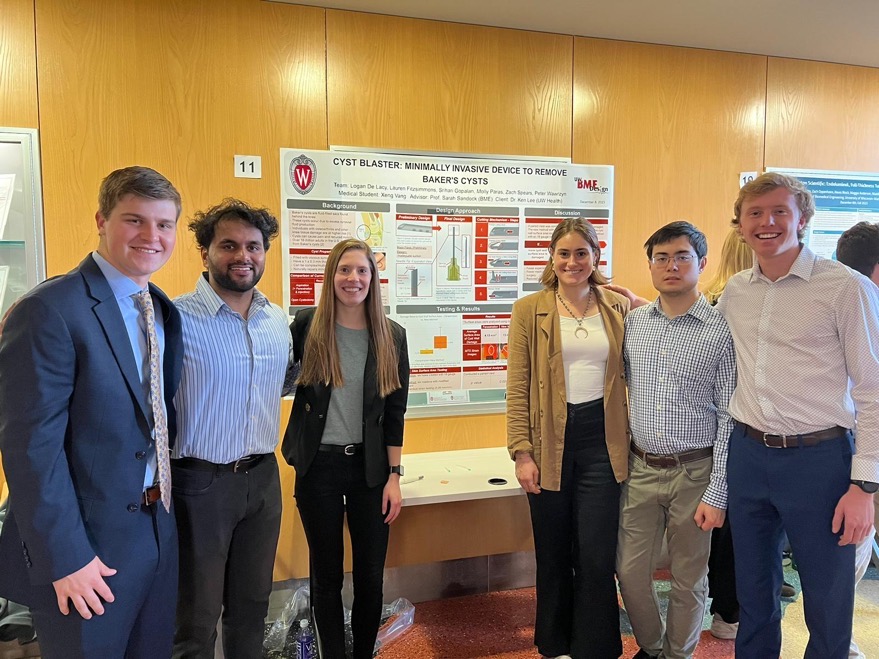Cyst blaster: minimally invasive device to remove baker cysts
This project has been secured to protect intellectual property.
Login for More InformationDevelopment of a safe and more effective device compatible with minimally invasive outpatient procedures that prevents Baker’s cysts.
Design Award
- BME and UWSMPH-TECH Collaborative Innovation Award Winner
Project Overview
Cysts are fluid-filled sacs that form throughout the body due to a buildup of fluid and biological material. Baker cysts, also known as popliteal cysts, are cysts found behind the knee joint in about 5% of adults in the U.S., and are typically positioned between the semimembranosus and medial head of the gastrocnemius [1]. These cysts are commonly caused by osteoarthritis, meniscus tears, and other sources of tissue damage, in which inflammation causes synovial fluid production to increase and spread to the bursa [2]. Those most affected are former athletes, physical laborers, and individuals over the age of 35 [3]. Popliteal cysts are commonly asymptomatic in 76.5% of the cases, with some resolving without intervention. The remaining 23.5% of patients may experience pain, swelling, and limited movement in their knee joint and are likely to seek treatment [4]. A common minimally invasive approach is taken for symptomatic cysts; this involves using a small needle to aspirate the fluid within the sac. However, when the only treatment is aspiration, cysts recur in about ⅔ of those treated [5]. If the cyst recurs following aspiration, an open surgical approach may be used to remove the cyst. In cases where surgery is being performed to treat the underlying cause of the cyst, a doctor may suggest surgical removal of the cyst rather than aspiration. These surgical approaches involve a cystectomy, the physical resection of the cyst wall, leading to a 1.94% recurrence rate [6]. Disadvantages of an open cyst excision compared to cyst aspiration is a longer surgery time at 62.5 ± 9.6 min, an incision of 10.6 ± 1.8cm [7]. These factors can be costly for both the hospital and the patient; the in-network cost of surgical removal of a Baker’s cyst alone is roughly 5 times as expensive as an ultrasound-guided aspiration and/or injection [8, 9]. Additionally, a cyst aspiration does not require an inpatient stay at the hospital. A safe and more effective device compatible with minimally invasive outpatient procedures must be developed that prevent Baker’s cysts.
Team Picture

Contact Information
Team Members
- Molly Paras - Co-Team Leader
- Zach Spears - Co-Team Leader
- Peter Wawrzyn - Communicator
- Srihari Gopalan - BSAC
- Lauren Fitzsimmons - BWIG
- Logan De Lacy - BPAG
- Vang Xeng
Advisor and Client
- Prof. Sarah Sandock - Advisor
- Dr. Ken Lee - Client
Related Projects
- Spring 2025: Cyst blaster: minimally invasive device to remove baker cysts
- Fall 2024: Cyst blaster: minimally invasive device to remove baker cysts
- Spring 2024: Cyst blaster: minimally invasive device to remove baker cysts
- Fall 2023: Cyst blaster: minimally invasive device to remove baker cysts
